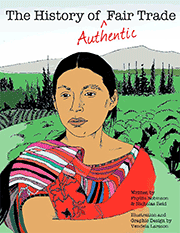By Nicholas Reid, Natural Foods Sales Representative
“For me, it’s all about co-ops. I just want to go back and teach co-op.”
-Margaret Mills, Grocery Manager, People’s Food Co-op, Lacrosse, Wisconsin
This March, I had the honor of visiting a community of our farmer partners in Chiapas, Mexico. No one could summarize my feelings about the trip better than Margaret, who came with us from People’s Food Co-op in Lacrosse. The community of Las Pilas, and the 17 members of the co-operative, CESMACH, offered us a fundamental lesson on the value of co-ops in the fair trade system. Campesinos Ecologicos de la Sierra Madre de Chiapas S. C. gives its farmers infinitely more than a fair price, or processing and marketing expertise for their coffee. Through education, community development, health projects, and environmental initiatives, CESMACH adds value we cannot measure – and can barely comprehend – to the work and lives of our farmer-partners. I, too, walked away from my time in Las Pilas wanting to go home and “teach co-op.”

In addition to producing some of the highest-quality coffee in the world, the farmers of CESMACH are a mind-boggling example of our partners’ commitment to environmental sustainability- growing high-quality, organic coffee in a way that not only preserves the U.N.-designated biosphere in which they live, but also rehabilitates the land, soil and water, and is reintroducing native, endangered species. The co-op has converted over 400 farmers to organic production, and has embarked on several income diversification and food sovereignty projects that incorporate ecological preservation. They do it all with ingenuity and respect, on depressingly-limited resources.
A Fair Price?
Walking through the multitude of steps in the process of harvesting the coffee crop with the farmers themselves, the first thing you realize is that there is nothing “fair” about the Fair Trade price. I would last about a minute as a coffee farmer in southern Mexico – it’s back-breaking, pain-staking hard labor. Given the amount of work it takes, five dollars a pound might be fair. Five dollars might send their children to school, and pay for food, medicine, and someday, indoor plumbing. Five dollars would be inspiring. Many alternative trade organizations pay more than the internationally-established minimum price, $1.56 per pound, and Equal Exchange has paid more than $2/lb. But it’s still such an incredibly mind-numbing amount of work that $2/lb, or even $5/lb seems not entirely fair. Until consumers in the U.S. are willing to pay $20/lb (and I’m working on it), the farmers will have to continue to make hard choices about investing in their co-op business, their communities and their families… But they have each other; they have their co-op. And compared to coffee farmers who don’t, there’s no comparison at all. Those farmers will have to look elsewhere for a future less bleak.

Just before we left, after explaining the cost of international shipping, the importance and expense of multi-ply coffee bags with one-way valves, and the dynamics of supply and demand to the group of indignant families, “we get $2 and you sell it for $6!!!”, just for a moment, I felt despair replace the travel-induced nausea in my stomach. Is this what I work for? To get these farmers a $2/pound?! I lose that much in a week through the hole in my favorite Levi’s. But I remembered, no one who truly understands Equal Exchange thinks that “paying a higher price to farmers” is where our workday starts and ends. I looked back on my time in Las Pilas, at the moments of awe and inspiration, to remember that together with our partners, farmers and consumers, Equal Exchange is building a movement, epitomized by progress and momentum that has only just begun – while also building a new economy, founded on co-operatives. CESMACH brings to their farmers what the Fair Trade price alone cannot, and what no price could: education, community, support, invention, investment, conscience … value.
Women’s Initiatives
The women of Las Pilas are engaged in a chicken project, organized by their co-op, funded by Equal Exchange (among others) and our consumers. The women provided wood and a metal roof, and the co-op provided them with 35 native chickens, wire mesh to enclose the coop, and a training program on caring for chickens and using native, natural medicines to care for their poultry.
 The women take turns, two each day, caring for the chickens, providing corn and collecting eggs. The eggs are for consumption, adding protein and nutrients to the community’s diet, and saving the families two pesos per egg. When the first round of fertilized eggs hatch the farmers will “repay” the co-op by sending 35 chickens to another group of women in a neighboring community. After that, the women will sell the higher-valued, live creole chickens at market for a going rate of 120 pesos per chicken, compared to 80 for the less resilient, commercial ranchero chickens that dominate poultry sales in Southern Mexico. The women are growing their own food, cutting down on the cost of food they eat, and supporting local species in and environmentally-responsible way, a perfectly sustainable income-diversification and food sovereignty project.
The women take turns, two each day, caring for the chickens, providing corn and collecting eggs. The eggs are for consumption, adding protein and nutrients to the community’s diet, and saving the families two pesos per egg. When the first round of fertilized eggs hatch the farmers will “repay” the co-op by sending 35 chickens to another group of women in a neighboring community. After that, the women will sell the higher-valued, live creole chickens at market for a going rate of 120 pesos per chicken, compared to 80 for the less resilient, commercial ranchero chickens that dominate poultry sales in Southern Mexico. The women are growing their own food, cutting down on the cost of food they eat, and supporting local species in and environmentally-responsible way, a perfectly sustainable income-diversification and food sovereignty project.
Ecological Projects
The co-op members of Las Pilas, far from idle when not working on their coffee farms, are engaged in a “species rescue” and reforestation project, likewise organized by CESMACH, and paid for with Fair Trade dollars. We were lucky enough to visit the community-owned vivero, or nursery, located a short hike above the community (“short hike” being a relative term), in a small valley in the mountains and cloud forest. There, the farmers have been provided with shade mesh, and seeds or cuttings for three different tree species: the endangered Camador Palm (genus, chamaedorea, maybe) the near-extinct Tomato Tree, and the also-endangered Pacaya Palm tree.

As always, the efficiency and genius of CESMACH is astounding. Never ones to waste an opportunity, the Camador Palms will be replanted on the community-members’ coffee plots that dot the surrounding hillsides, beautifully distinguishable in that they are often green oases in otherwise barren, deforested, mudslides-waiting-to-happen. Not only will they provide shade for the coffee production and root systems to prevent erosion and soil-degradation, the co-op has begun harvesting and exporting the fronds for Palm Sunday. My pilgrimage to Chiapas in 2008 included a tutorial on palm harvesting by CESMACH-contracted agronomists training the farmers of Rio Negro for a palm pilot project, now being replicated by 10 other communities in the co-op.
The wild tomato tree and pacaya are fruit trees on the roster of endangered, under-studied and largely unknown species that thrive in the jungles and cloud forests of the developing world. The tomatoes are similar to our own, although harder and fleshier, like a tomatillo.

The Endangered Tree Tomato
The pacaya is a berry, similar to a lychee in appearance, and is harvested in husks that look like young ears of corn. Once the plantings have graduated from the Las Pilas nursery in about a year, they too will be replanted in the coffee matas to provide shade and soil stability. But they will also provide fruit and nourishment to the families of Las Pilas, produce to be sold (once the farmers have had their fill of tree tomatoes, to go with the wild avocados that grow in the matas) at market alongside the trees themselves, the value of which increases as their numbers decline, to supplement their income from coffee. As soon as the rainy season begins, the co-op will also plant organic gardens and orchards to provide additional food security to its members. Genius.

Social & Health Projects
As difficult as it is to assign a value to the social projects at CESMACH, it is even harder to understand the sense of belonging and the value the co-op provides as an advocate for its members, or the structural support provided where nothing else is available. When Hurricane Stan hit southern Mexico and Guatemala in 2005, houses, roads and bridges were destroyed – leaving hundreds of CESMACH farmers with next to nothing, isolated in the rubble of their former communities. The co-op was a lifeline to the outside world, as self-help groups were organized to bring medicine, food and supplies to the communities. Emergency aid funds were raised by Equal Exchange and our partners (food co-ops, Interfaith organizations and consumers) to help rebuild. It was the co-op that came looking for them.
When three medical workers from Grounds for Health arrive in Chiapas to spread awareness on cervical cancer and women’s health, the co-operative provides the space and the format to disseminate education, testing and care. We walked in on a room full of “health promoters,” each representing their own community, at a workshop in the co-op warehouse on cervical cancer, which has an incidence in southern Mexico that is 30 percent higher than in the United States. CESMACH is a network for human development, not just economic gain.

Transformative Economic Change
At the end of the day, the Fair Trade price is still too little, and the traditional signs of “progress” are only just appearing, but below the surface there is an energy, a sense of collective action and progress, investment and change. The co-operative has brought 440 families in Southern Mexico together with purpose, and is focusing their synergy on human development, social change and on community. They are refusing to make the same mistakes the U.S. did in our sprint to “development,” by protecting their environment, and promoting equality, health, women’s rights and collective empowerment. The CESMACH co-operative makes the difference between “paying higher prices” and transformative economic change. And that’s what Fair Trade is about. That’s value added.










